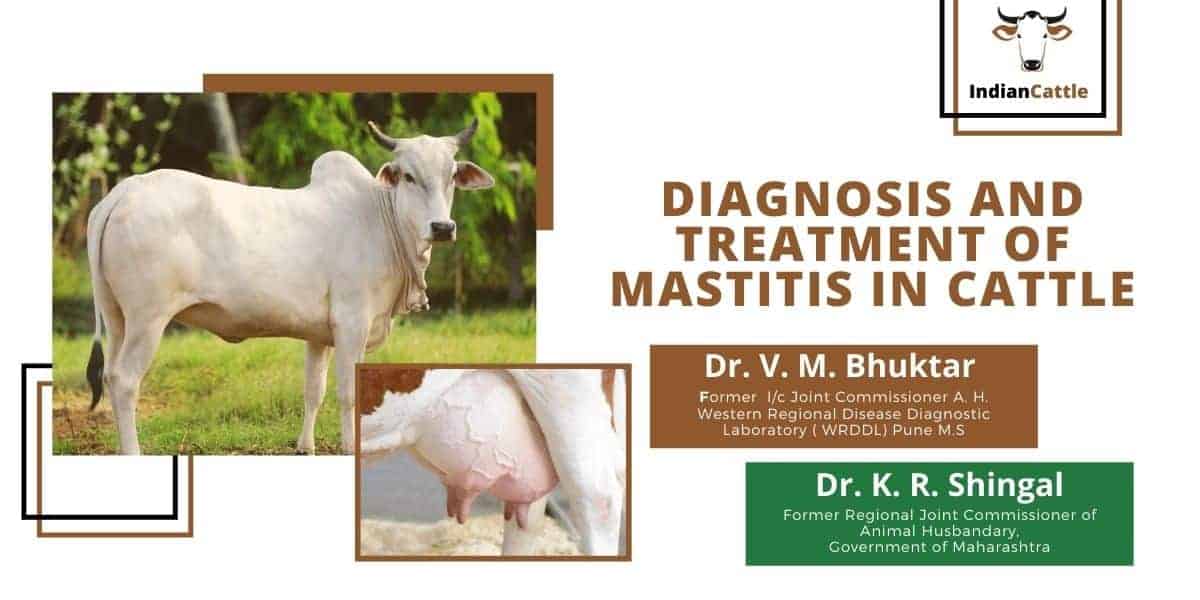
Diagnosis and Treatment of Mastitis in Cattle
Bovine mastitis is the inflammation of mammary glands and udder tissue. Generally, the disease occurs throughout the world in dairy cattle Mastitis is a multifactorial disease, closely related to the production and environment that cows are kept in. Mostly It may occur due to micro-organisms in teat canal causing inflammation. Sometimes, mechanical, chemical or thermal injury may cause the disease condition. Mastitis, especially sub-clinical, causes heavy economic losses due to loss of milk production.
Etiology: Bacteria, Pseudomonas aeruginosa, Staphylocccus aureus, Staphylococcus epidermidis, Streptococcus agalactiae, Streptococcus uberis, Brucella melitensis, Mycoplasma spp (including Mycoplasma bovis), Escherichia coli(E.coli), Klebsiella pneumoniae, Klebsiella oxytoca, Serratia spp., Enterobacter aerogenes, Pasteurella spp., Truperella pyrogenes, (Previously Arcanobacterium pyogenes), Proteus spp., Prototheca zopfii, (achorophyllica agae). Calf management practices milking machines, through contaminated hands of materials, Fungal Species(yeast or molds), Certain microscopic algae (Prototheca spp) and Viruses can cause IMI. Physical trauma or chemical irritation are less common causes of mastitia.
Species Affected: Cows, Buffaloes, Sheep, Goats and Pigs
Mode of Transmission: The main source of infection is udder of infected animal. Contamination in the environment may provide ready source of infection. The other source is via the oral-to udder transmission among calves. Teats, skin of cattle, floors, milkers’ hands, utensils and cloths are often contaminated. Milking machine, if not properly maintained can also act as a medium of infection transmission.
Clinical Symptoms: Fever in some cases, inflammation of mammary glands, they may not be painful, presence of clots, watery fore milk, swelling and redness of udder, sometimes it feel hot and painful, milk with blood, purulent or contains thick clots. If not treated or no response to treatment, it may lead to extensive fibrosis and loss of function. In some cases, gangrenous mastitis, the life of the animal is also in danger. The clinical symptoms depend on the type i.e. clinical mastitis, sub- clinical and chronic mastitis.
How mastitis affects milk production: In mastitis the micro-organisms multiply and produce toxins that cause injury to milk-secreting tissue and ducts. As a consequence, the quality and quantity of dairy products may be affected.
Effect on Milk: Change in colour, smell and consistency. In some cases, milk may turn watery, contain blood, purulent, or clots in the milk. Mastitis can cause decrease in potassium and an increase in lactoferrin. It also results in decreased casein, the major protein in milk as well as calcium. Mastitis leads to an increase in number of leucocytes in milk, also called somatic cells.
Material to be collected for laboratory examination: Milk from the affected quarter in sterile bottle and kept on ice, preferably before commencing antibiotic treatment.
Diagnosis of Mastitis in Cattle
Diagnosis of mastitis is based on the physical examination of udder and milk, and symptoms and udder examination.
- From clinical picture
- California mastitis test.
- Milk sediment smear examination.
Differential Tests in the Laboratory
- Isolation and identification of the causal organisms and
- Drug sensitivity test.
Treatment of Mastitis in Cattle
As per drug sensitivity test the affected animal should be treated. Repeated and complete milking is an important part of treatment which helps in removal of toxic and bacteria-contaminated milk. In case there is swelling which is hot and painful, cold fomentation with ice cubes is helpful.
The main treatment of mastitis is commonly administered by intramammary infusion of ointment. Antibiotics, such as streptomycin, ampicillin, penicillin, cloxacillin and tetracycline are used. Pain relievers like ibuprofen or acetaminophen are also used to reduce inflammation and swelling.
Prophylaxis: Sound hygiene and sanitary practices are the backbone of udder health programs. Maintaining dry floor and avoiding washing of animals definitely leads to reduction in mastitis cases. The second element is use practicing pre milking cleaning and disinfection, sanitisation of milking units and covering the teats with germicides after milking. In mastitis-affected cow, separate milk of each quarter should be tested and milk of affected quarter should be disposed by deep- burying along with 5% of phenol. The calf should not be allowed to suckle milk to affected quarter. Milkers should be advised to use of antiseptic hand wash. Utensils should be cleaned and disinfected before and after milking. Floor should be cleaned and disinfected regularly.
Read: Diagnosis of Poisoning: Selection and Submission of Samples for Laboratory Investigations
| Dr. V. M. Bhuktar
Former I/c Joint Commissioner A. H. Western Regional Disease Diagnostic Laboratory (WRDDL) Pune M.S |
Dr. K. R. Shingal B.V.Sc. & A.H., M.V.Sc., N.D.B.P |
